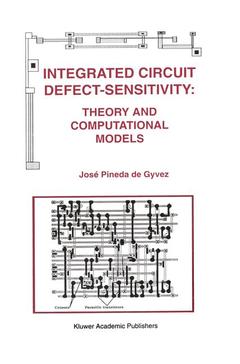Description
Integrated Circuit Defect-Sensitivity: Theory and Computational Models, Softcover reprint of the original 1st ed. 1993
The Springer International Series in Engineering and Computer Science Series, Vol. 208
Author: Pineda de Gyvez José
Language: English
Keywords
circuit; design; electronics; integrated circuit; microelectronics; model; modeling
Publication date: 02-2014
167 p. · 15.5x23.5 cm · Paperback
167 p. · 15.5x23.5 cm · Paperback
Description
/li>Contents
/li>
The history of this book begins way back in 1982. At that time a research proposal was filed with the Dutch Foundation for Fundamental Research on Matter concerning research to model defects in the layer structure of integrated circuits. It was projected that the results may be useful for yield estimates, fault statistics and for the design of fault tolerant structures. The reviewers were not in favor of this proposal and it disappeared in the drawers. Shortly afterwards some microelectronics industries realized that their survival may depend on a better integration between technology-and design-laboratories. For years the "silicon foundry" concept had suggested a fairly rigorous separation between the two areas. The expectation was that many small design companies would share the investment into the extremely costful Silicon fabrication plants while designing large lots of application-specific integrated circuits (ASIC's). Those fabrication plants would be concentrated with only a few market leaders.
1 Introduction.- 1.1 Approaches to Yield Modeling.- 2 Defect Semantics and Yield Modeling.- 2.1 Microelectronics Technology.- 2.2 Modeling of Process Induced Defects and Faults.- 2.3 Statistical Characterization of Spot Defects.- 2.4 Brief Overview of Historical Yield Models.- 3 Computational Models for Defect-Sensitivity.- 3.1 Taxonomy of Defect—Sensitivity Models.- 3.2 Theoretical Foundation of Critical Areas.- 3.3 Susceptible Sites.- 3.4 Critical Regions and Critical Areas.- 3.5 Geometrical Proof of the Construction of Critical Regions..- 4 Single Defect Multiple Layer (SDML) Model.- 4.1 Critical Regions for Protrusion Defects.- 4.2 Critical Regions for Isolated Spot Defects.- 4.3 Critical Regions for Intrusion Defects.- 4.4 A CAD System for SDML Critical Areas.- 4.5 A “Spot-Defect” Language.- 4.6 Layout Partitioning.- 4.7 Extraction of Multi—Layer Susceptible Sites.- 4.8 Defect Mechanisms.- 4.9 Intrusion Defects.- 4.10 Isolated—Spot Defects.- 4.11 Protrusion Defects.- 4.12 Construction of Multi—Layer Critical Regions.- 4.13 Computation of Multi—Layer Critical Areas.- 4.14 Notes on Implementation.- 4.15 Examples.- 5 Fault Analysis and Multiple Layer Critical Areas.- 5.1 Failure Analysis and Yield Projection of 6T—RAM Cells.- 5.2 Fault Weighting.- 5.3 Analysis and Weighting of Defect Induced Faults.- 6 Single Defect Single Layer (SDSL) Model.- 6.1 Theory of Critical Regions for SDSL Models.- 6.2 Single—Layer Susceptible Sites.- 6.3 Critical Regions for Bridges.- 6.4 Critical Regions for Cuts.- 6.5 Computation of Critical Areas for SDSL Models.- 6.6 Extraction of SDSL Susceptible Sites.- 6.7 Computation of SDS Critical Areas.- 6.8 Complexity Analysis.- 6.9 Examples.- 7 IC Yield Prediction and Single Layer Critical Areas.- 7.1 Sensitivity Analysis.-7.9 Yield Analysis.- 8 Single vs. Multiple Layer Critical Areas.- 8.1 Uncovered Situations of the SDSL Model.- 8.2 Case Study.- 8.2.1 Comparative Results.- 8.3 Summary and Discussion.- References.- Appendix 1 Sources of Defect Mechanism.- Appendix 2 End Effects of Critical Regions.- Appendix 3 NMOS Technology File.
© 2024 LAVOISIER S.A.S.
These books may interest you

Millimeter-Wave Low Noise Amplifiers 121.31 €

Millimeter-Wave Low Noise Amplifiers 168.79 €


